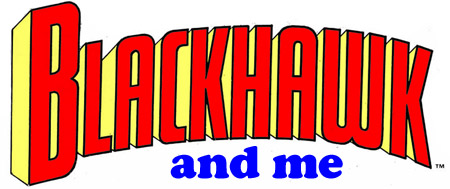Before you read this, you might want to read Part 1 and Part 2.

Sales on DC's Blackhawk comic book declined throughout the sixties. In 1967, its editor George Kashdan was told the comic was heading towards cancellation and something had to be done to change that trajectory. He had several meetings about this with Carmine Infantino, who was more and more calling the creative shots at DC. Infantino had been hired as Cover Editor, then upped to Art Director…and even before he formally had the title of Editorial Director, he was directing all the editors.
Also in those meetings was writer Bob Haney, who was among a handful of writers who'd been scripting the book lately. The last few issues had been written by longtime DC (and Blackhawk) writer France "Eddie" Herron and his exclusion from these meetings presumably had something to do with the fact that he passed away around this time. When I reminded Mr. Kashdan of that, he said, "Eddie was spared seeing what we had to do to that comic."

From out of those meetings came the decision to turn Blackhawk into an unabashed super-hero comic. The cover of #228 showed Superman, Batman, Flash and Green Lantern discussing the Blackhawk team and declaring that they were "washed-up" and Batman even called them "Junk-Heap Heroes." That set the stage for those team members to each adopt a new costumed identity two issues later. This was probably a bad idea even if they hadn't come up with some of the silliest costumed identities ever seen in a comic book.
One member of the squad, Chuck, became "The Listener," an expert in eavesdropping clad in a super-hero suit with ears all over it. Olaf, the team muscle-man, became "The Leaper," dressed no better and now able to bounce and leap about like he could fly. Andre, the suave French member of the squadron, became "M'sieu Machine," an expert in technology. The rest looked just as dumb and the stories read like Haney was studying current Marvel Comics and learning all the wrong lessons about what readers liked about them. (Haney showed better understanding of the Marvel dynamic when he'd co-created and wrote Metamorpho for DC but that comic, after initial strong sales, had nosedived and was in no better sales shape than Blackhawk.)
I'm guessing a lot of its readers looked upon the changes as I did: With the facial expression of the opening night audience watching Max Bialystock's new Broadway show, Springtime for Hitler…though we never got as far as the part when we began to find it funny. A few years earlier, I had finally started buying Blackhawk comics and developed a fondness for the property, not so much because of its current issues but because of the older ones I was finding at second-hand bookshops. In fact, the older an issue was, the more I generally liked it. When I finally got my mitts on some from the 1940s, I became a huge fan of the series. Until they donned those ridiculous costumes.
The Blackhawks' new identities did nothing to stop the bleeding in 1967, and Kashdan told me the new look may even have hastened the descent. In early '68, the comic's frequency of publication was cut from monthly to bi-monthly and it stopped being George Kashdan's problem because he was let go as a DC editor. He had worked for the company as a writer and then a writer-editor since 1947.
So what happened next to Blackhawk? Well, the comic did not survive for long but before it went away for a while, an interesting thing happened. Kashdan's replacement got his desk and one day, he opened a drawer and found something odd. I'll tell you about it in the next part.